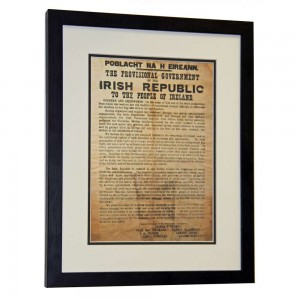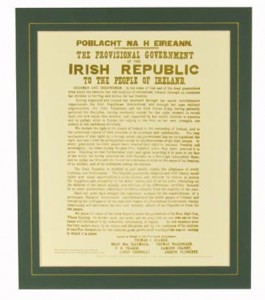 Ireland will always be indebted to the 1916 Martyrs as they live long in Irish History.
Ireland will always be indebted to the 1916 Martyrs as they live long in Irish History.
Following the surrender of the Easter Rising, the Rebel leaders were tried, court-martialed and executed by firing squad in the former stonebreakers yard at Kilmainham Prison, Dublin, from May 3rd to May 12th 1916, with Roger Casement being court-martialed and hanged in the U.K. on 3rd August 1916.
General Sir John Grenfell Maxwell, general officer commanding-in-chief of the British forces in Ireland, oversaw the court-martials of the 1916 Martyrs,
I am going to ensure, that there will be no treason whispered for 100 years.
However, the executions had completely the opposite effect that General Maxwell had presumed, swinging popular opinion in support of the rebels. During and immediately after the Easter Rising Dubliners mainly held the rebels in contempt, holding them responsible for their misery and the destruction of much of Dublin city. But as General Maxwell began to excute ‘their boys’, Dubliners had an enormous change of attitude. Also adding fuel to the fire, the British authorities refused to release the bodies of the leaders of the 1916 Rising for fear their funerals would garner further support for the Irish cause.
The fourteen leaders executed at Kilmainhaim Gaol were buried in sequence of their execution, they had no coffins and were buried in a pit of quicklime at Arbour Hill Cemetery (in Arbour Hill prison), which was the burial ground for the British garrison since early 1700s. The church beside this cemetery is now the church of the Irish Defence Forces.
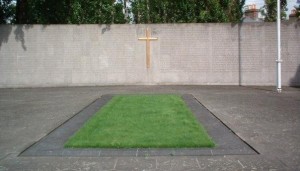 To respect the 1916 martyrs, the names of the leaders are engraved in Irish at the head of this grave and at the foot of the grave the names are engraved in English. The Irish Proclamation is engraved in both English and Irish on the background wall of the cemetery. Different annual commemorations are held at Arbour Hill Cemetery by various political parties and also by the Irish Government of the day.
To respect the 1916 martyrs, the names of the leaders are engraved in Irish at the head of this grave and at the foot of the grave the names are engraved in English. The Irish Proclamation is engraved in both English and Irish on the background wall of the cemetery. Different annual commemorations are held at Arbour Hill Cemetery by various political parties and also by the Irish Government of the day.
Easter 1916 by W.B. Yeats
I write it out in a verse –
MacDonagh and MacBride
And Connolly and Pearse
Now and in time to be,
Wherever green is worn,
Are changed, changed utterly:
A terrible beauty is born.
1916 Martyrs in sequence of their court-martial and execution
Executed by firing squad, 3rd May 1916, between 3.30 a.m. – 4.00 a.m., Kilmainham Gaol:
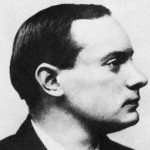 Padraig Pearse (signatory to the Irish Proclamation), born in Dublin, 1879 and developed a strong interest in Irish culture in his teenage years. In 1896, Pease joined the Gaelic league at the age of 16 and was to become a member of the Executive Committee. Pearse graduated from the Royal University 1901, with a degree in Arts & Law. He published extensively in both Irish and English and in 1903 he became editor of the newspaper of the Gaelic League ‘An Claidheamh Soluis’. With Thomas MacDonagh, Padraig Pearse founded St. Enda’s school in Rathfarhnam, Dublin. Pearse was a founder member of the Irish Volunteers and also joined the Irish Republican Brotherhood (IRB). He was Commander in Chief of the Irish forces and commander in the GPO during the Rising, holding out for nearly a week before surrendering. It was Pearse who read out the Irish Proclamation on the steps of the GPO on Easter Monday 1916.
Padraig Pearse (signatory to the Irish Proclamation), born in Dublin, 1879 and developed a strong interest in Irish culture in his teenage years. In 1896, Pease joined the Gaelic league at the age of 16 and was to become a member of the Executive Committee. Pearse graduated from the Royal University 1901, with a degree in Arts & Law. He published extensively in both Irish and English and in 1903 he became editor of the newspaper of the Gaelic League ‘An Claidheamh Soluis’. With Thomas MacDonagh, Padraig Pearse founded St. Enda’s school in Rathfarhnam, Dublin. Pearse was a founder member of the Irish Volunteers and also joined the Irish Republican Brotherhood (IRB). He was Commander in Chief of the Irish forces and commander in the GPO during the Rising, holding out for nearly a week before surrendering. It was Pearse who read out the Irish Proclamation on the steps of the GPO on Easter Monday 1916.
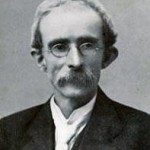 Thomas James Clarke (first signatory to the Irish Proclamation due to his seniority), born on the Isle of Wight, 1857. Clarke’s father was a soldier in the British army. He spent time in America as a young man where he joined Clann na nGael, and on his return to America a number of years later this connection to Clann na nGael held him in a strong position in the revolutionary movement in Ireland and influenced Sean MacDiarmada, Joseph Mary Plunkett and Padraig Pearse. Clarke served a 15 year prison term for his part in a bombing campaign in London, 1883-1898. He was treasurer of the Irish Republican Brotherhood and a member of the Supreme Council from 1915. Clarke occupied the GPO during the 1916 Rising, as he had been naturalised in Brooklyn while in exile, he was the only one of the executed 1916 Martyrs to be an American citizen.
Thomas James Clarke (first signatory to the Irish Proclamation due to his seniority), born on the Isle of Wight, 1857. Clarke’s father was a soldier in the British army. He spent time in America as a young man where he joined Clann na nGael, and on his return to America a number of years later this connection to Clann na nGael held him in a strong position in the revolutionary movement in Ireland and influenced Sean MacDiarmada, Joseph Mary Plunkett and Padraig Pearse. Clarke served a 15 year prison term for his part in a bombing campaign in London, 1883-1898. He was treasurer of the Irish Republican Brotherhood and a member of the Supreme Council from 1915. Clarke occupied the GPO during the 1916 Rising, as he had been naturalised in Brooklyn while in exile, he was the only one of the executed 1916 Martyrs to be an American citizen.
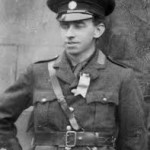 Thomas MacDonagh (signatory to the Irish Proclamation), born in Tipperary, 1878. MacDonagh was a poet, author and teacher, he moved to Dublin to study and with Padraig Pearse he founded St. Enda’s school in Rathfarnham. MacDonagh was a lecturer at the English Department, University College Dublin. He wrote the play ‘When the Dawn is Come’, which was produced at the Abbey Theatre. MacDonagh was married to Muriel Gifford, who was the sister of Grace Gifford, who married Joseph Mary Plunkett in Kilmainham Gaol just before he was executed. In 1914 MacDonagh became Director of Training with the Irish Volunteers. And in 1916 was appointed to the IRB military committee. He was Commander of the Second Battalion of Volunteers and occupied Jacob’s biscuit factory during the 1916 Rising.
Thomas MacDonagh (signatory to the Irish Proclamation), born in Tipperary, 1878. MacDonagh was a poet, author and teacher, he moved to Dublin to study and with Padraig Pearse he founded St. Enda’s school in Rathfarnham. MacDonagh was a lecturer at the English Department, University College Dublin. He wrote the play ‘When the Dawn is Come’, which was produced at the Abbey Theatre. MacDonagh was married to Muriel Gifford, who was the sister of Grace Gifford, who married Joseph Mary Plunkett in Kilmainham Gaol just before he was executed. In 1914 MacDonagh became Director of Training with the Irish Volunteers. And in 1916 was appointed to the IRB military committee. He was Commander of the Second Battalion of Volunteers and occupied Jacob’s biscuit factory during the 1916 Rising.
Executed by firing squad, 4th May 1916, between 3.30 a.m. – 4.00 a.m., Kilmainham Gaol:
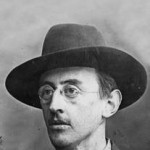 Joseph Mary Plunkett (signatory to the Irish Proclamation), born in Dublin, 1887. Plunkett’s father was a papal count, he was educated in England and returned to Ireland where he graduated from U.C.D. in 1909. Plunkett travelled for two years before returning to Dublin in 1911. He has a love of literature and was to become editor of the Irish Review. With Thomas MacDonagh and Edward Martyn he established an Irish national theatre. He joined the Irish Volunteers in 1913 and became a member of the IRB in 1914. Plunkett was the Movement’s foreign minister and he travelled to Germany to meet Roger Casement in 1915. During the 1916 Rising he was Director of Military Operations with overall responsibility for military strategy. Micheal Collins was his personal bodyguard and aide-de-camp, although at the time of the rising he was actually dying of T.B. During the 1916 Rising he occupied the GPO. While imprisioned in Kilmainham Gaol following the surrender he married Grace Gifford (sister of Muriel Gifford, who was married to Thomas MacDonagh), in the Catholic chapel at Kilmainham, shortly following was taken out for execution.
Joseph Mary Plunkett (signatory to the Irish Proclamation), born in Dublin, 1887. Plunkett’s father was a papal count, he was educated in England and returned to Ireland where he graduated from U.C.D. in 1909. Plunkett travelled for two years before returning to Dublin in 1911. He has a love of literature and was to become editor of the Irish Review. With Thomas MacDonagh and Edward Martyn he established an Irish national theatre. He joined the Irish Volunteers in 1913 and became a member of the IRB in 1914. Plunkett was the Movement’s foreign minister and he travelled to Germany to meet Roger Casement in 1915. During the 1916 Rising he was Director of Military Operations with overall responsibility for military strategy. Micheal Collins was his personal bodyguard and aide-de-camp, although at the time of the rising he was actually dying of T.B. During the 1916 Rising he occupied the GPO. While imprisioned in Kilmainham Gaol following the surrender he married Grace Gifford (sister of Muriel Gifford, who was married to Thomas MacDonagh), in the Catholic chapel at Kilmainham, shortly following was taken out for execution.
 William Pearse, born in Dublin, 1881, younger brother of Padraig Pearse. William Pearse was a talented sculpture and he help his brother run St. Enda’s school in Ratherfarnham. During the 1916 Rising he fought with his brother at the GPO. He was most probably only executed because he was Padraig Pearse’s brother. Pearse railway station at Westland Row, Dublin, was renamed in 1966 in honour of the two Pearse brothers.
William Pearse, born in Dublin, 1881, younger brother of Padraig Pearse. William Pearse was a talented sculpture and he help his brother run St. Enda’s school in Ratherfarnham. During the 1916 Rising he fought with his brother at the GPO. He was most probably only executed because he was Padraig Pearse’s brother. Pearse railway station at Westland Row, Dublin, was renamed in 1966 in honour of the two Pearse brothers.
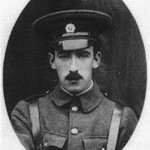 Edward Daly, born in Limerick, 1891. Daly’s father was a republican activist and his uncle John Daly took part in the 1867 rebellion. During the 1916 Rising, Edward Daly was leader of the First Battalion and raided the Bridewell and Linenhall Barracks and also seized the Four Courts. Daly was a close friend of Tom Clarke, who married Daly’s sister.
Edward Daly, born in Limerick, 1891. Daly’s father was a republican activist and his uncle John Daly took part in the 1867 rebellion. During the 1916 Rising, Edward Daly was leader of the First Battalion and raided the Bridewell and Linenhall Barracks and also seized the Four Courts. Daly was a close friend of Tom Clarke, who married Daly’s sister.
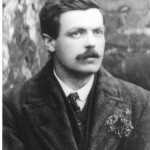 Michael O’Hanrahan, born in Wexford, 1877. O’Hanrahan founded the first Carlow branch of the Gaelic League. He published two novels, a Swordsman of the Brigade and When the Norman Came. O’Hanrahan was a member of the Irish Volunteers and was second in command to Thomas MacDonagh at Jacob’s biscuit factory during the 1916 Rising.
Michael O’Hanrahan, born in Wexford, 1877. O’Hanrahan founded the first Carlow branch of the Gaelic League. He published two novels, a Swordsman of the Brigade and When the Norman Came. O’Hanrahan was a member of the Irish Volunteers and was second in command to Thomas MacDonagh at Jacob’s biscuit factory during the 1916 Rising.
Executed by firing squad, 5th May 1916, between 3.47 a.m., Kilmainham Gaol:
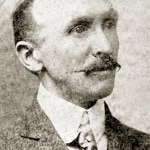 John MacBride, born in Mayo, 1865. McBride trained as a doctor initially then changed career to work with a chemist. He travelled to America in 1896 to further the aims of the IRB. He also travelled to South Africa, where he formed the Irish Transvaal Brigade during the Second Boer War. McBride married Maude Gonne in 1903, their son Seán MacBride received the Nobel Peace Prize in 1974. MacBride was not a member of the Irish Volunteers and at the time of the 1916 Rising he was actually on his way to his brother’s wedding reception when he ran into the revolution and decided to take part offering his services to Thomas McDonagh at Jacob’s biscuit factory.
John MacBride, born in Mayo, 1865. McBride trained as a doctor initially then changed career to work with a chemist. He travelled to America in 1896 to further the aims of the IRB. He also travelled to South Africa, where he formed the Irish Transvaal Brigade during the Second Boer War. McBride married Maude Gonne in 1903, their son Seán MacBride received the Nobel Peace Prize in 1974. MacBride was not a member of the Irish Volunteers and at the time of the 1916 Rising he was actually on his way to his brother’s wedding reception when he ran into the revolution and decided to take part offering his services to Thomas McDonagh at Jacob’s biscuit factory.
Executed by firing squad, 8th May 1916, between 3.45 a.m. – 4.05 a.m., Kilmainham Gaol:
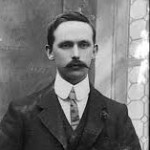 Éamonn Ceannt (signatory to the Irish Proclamation), born in Galway, 1991. Ceannt was an employee of the Dublin Corporation. He had a strong interest in Irish culture, Irish language and history and he played the Uileann Pipes. Ceannt was co-founder of the Irish Volunteers and was involved in the Howth gun-running operation in 1914. During the 1916 Rising Ceannt was Commander of the Fourth Battalion of Irish Volunteers Rising and took possession of the South Dublin Union (now St. James’ Hospital)
Éamonn Ceannt (signatory to the Irish Proclamation), born in Galway, 1991. Ceannt was an employee of the Dublin Corporation. He had a strong interest in Irish culture, Irish language and history and he played the Uileann Pipes. Ceannt was co-founder of the Irish Volunteers and was involved in the Howth gun-running operation in 1914. During the 1916 Rising Ceannt was Commander of the Fourth Battalion of Irish Volunteers Rising and took possession of the South Dublin Union (now St. James’ Hospital)
 Séan Heuston, born in Limerick, 1891. Heuston founded Fianna Éireann in Limerick. He also organsied the drill and musketry exercises at Padriag Pease’s Scoil Éanna. Heuston was in the First Battalion of the Volunteers and occupied the Mendicity Institute on south of the Liffey for two days. He was a railway worker and Heuston Railway station in Dublin is named after him.
Séan Heuston, born in Limerick, 1891. Heuston founded Fianna Éireann in Limerick. He also organsied the drill and musketry exercises at Padriag Pease’s Scoil Éanna. Heuston was in the First Battalion of the Volunteers and occupied the Mendicity Institute on south of the Liffey for two days. He was a railway worker and Heuston Railway station in Dublin is named after him.
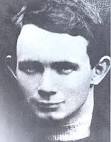 Con Colbert, born in Limerick, 1888. Colbert was a founder member of the Irish Volunteers and was also a member of Fianna Eireann. Colbert was well knows as a pioneer, neither drinking nor smoking. He drilled at Padriag Pearse’s school, Scoil Éanna and was Pearse’s bodyguard in the days just before the Easter Rising started. During the 1916 Rising Colbert captained the F Company of the Fourth Battalion, commanding at Marrowbone Lane distillery at the time of surrender.
Con Colbert, born in Limerick, 1888. Colbert was a founder member of the Irish Volunteers and was also a member of Fianna Eireann. Colbert was well knows as a pioneer, neither drinking nor smoking. He drilled at Padriag Pearse’s school, Scoil Éanna and was Pearse’s bodyguard in the days just before the Easter Rising started. During the 1916 Rising Colbert captained the F Company of the Fourth Battalion, commanding at Marrowbone Lane distillery at the time of surrender.
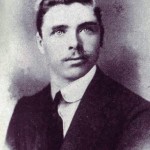 Michael Mallin, born in Dublin, 1874. Mallin was a silk weaver by trade. With Countess Markievicz he was a commander of a contingent of the Irish Citizen Army. During the 1916 Rising he was Chief of Staff and took possession of St Stephen’s Green and the Royal College of Surgeons.
Michael Mallin, born in Dublin, 1874. Mallin was a silk weaver by trade. With Countess Markievicz he was a commander of a contingent of the Irish Citizen Army. During the 1916 Rising he was Chief of Staff and took possession of St Stephen’s Green and the Royal College of Surgeons.
Executed by firing squad, 9th May 1916, Cork barracks:
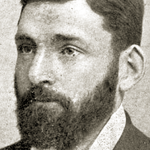 Thomas Kent, born in Cork, 1865. Kent was due to travel to Dublin to fight in the 1916 Rising, but on hearing the mobilisation for the Rising had been cancelled on Easter Sunday he remained in Cork presuming that the Rising had been postponed. On 22nd April 1916 his home in Castlelyons, Co. Cork, was raided by the Royal Irish Constabulary and Kent was arrested and his brother Richard was killed. In 1966, Cork railway station was renamed Kent Station in his honour.
Thomas Kent, born in Cork, 1865. Kent was due to travel to Dublin to fight in the 1916 Rising, but on hearing the mobilisation for the Rising had been cancelled on Easter Sunday he remained in Cork presuming that the Rising had been postponed. On 22nd April 1916 his home in Castlelyons, Co. Cork, was raided by the Royal Irish Constabulary and Kent was arrested and his brother Richard was killed. In 1966, Cork railway station was renamed Kent Station in his honour.
Executed by firing squad, 12th May 1916, between 3.45 a.m. – 4.05 a.m., Kilmainham Gaol:
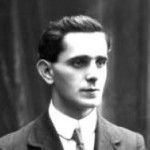 Seán MacDiarmada (signatory to the Irish Proclamation), born in Leitrim, 1884. MacDiarmada emigrated to Glasgow in 1900 and in 1902 he moved to Belfast. He was a member of the Gaelic League and when in Belfast he joined the IRB in 1906. MacDiarmada moved to Dublin in 1908 and in 1910 he became manager of IRB’s newspaper ‘Irish Freedom’. In 1912 he became infected with polio. In 1915 MacDiarmada was drafted onto the military committee of the IRB. During the 1916 Rising MacDiarmada occupied the GPO.
Seán MacDiarmada (signatory to the Irish Proclamation), born in Leitrim, 1884. MacDiarmada emigrated to Glasgow in 1900 and in 1902 he moved to Belfast. He was a member of the Gaelic League and when in Belfast he joined the IRB in 1906. MacDiarmada moved to Dublin in 1908 and in 1910 he became manager of IRB’s newspaper ‘Irish Freedom’. In 1912 he became infected with polio. In 1915 MacDiarmada was drafted onto the military committee of the IRB. During the 1916 Rising MacDiarmada occupied the GPO.
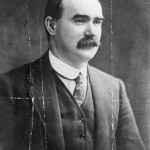 James Connelly (signatory to the Irish Proclamation & last of the leaders to be executed), born in Edinburgh, Scotland, 1868. Connelly was a member of the British army and he did a tour of duty in Ireland, following which he returned to Edinburgh in the mid-1890s and developed an interest in Irish politics influence by the large number of Irish in Edinburgh.
James Connelly (signatory to the Irish Proclamation & last of the leaders to be executed), born in Edinburgh, Scotland, 1868. Connelly was a member of the British army and he did a tour of duty in Ireland, following which he returned to Edinburgh in the mid-1890s and developed an interest in Irish politics influence by the large number of Irish in Edinburgh.
Connelly emigrated to Dublin in 1896 and he founded the Irish Socialist Republication Party. Along with James Larkin he campaign for worker’s rights and he also campaigned against religious bigotry. He was the co-founder of the Irish Citizen Army in 1913 and became Commandant General. During the 1916 Rising appointed Commandant-General of the Dublin Brigade and was acknowledge as the Commander-in-Chief and occupied the GPO. He was badly wounded in the leg during the Rising and doctors said he only had a matter of days to live, but his execution still went ahead and as he was unable to stand he was executed sitting in a chair.
Executed by hanging, 3rd August, Pentonville Prison, London, UK
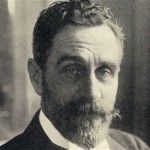 Roger Casement, born in Dublin, 1864. Casement worked as in the British consulate. He campaigned to expose the cruelty inflicted on native workers in the Belgian Congo in 1904 and in Peru in 1911-12 and was described as the ‘father of twentieth-century human rights investigation’. Casement was knighted for services to investigations in human rights. In 1904 Casement became a member of the Gaelic League and he wrote nationalist articles under the pseudonym ‘Sean Bhean Bhocht’. In 1913 he retired from the British consulate and went on to join the Irish Volunteers. Because of his consulate experience Casement was sent to Germany to raise an Irish Brigade from the Irish prisoners of war and to organise to land rifles in Co. Kerry ready for the Easter Rising, however, Casement was captured on his return to Ireland in a German U-Boat on Good Friday in 1916. He was imprisoned in Pentonville Gaol in London, where he was tried on charges of High Treason, stripped of his knighthood and hanged on 3rd August 1916. Casement was the only leader of the Rising to be executed outside of Ireland. Last of all the 1916 Martyrs to be executed, his bones were returned to Dublin in 1965 and buried at Glasnevin cemetery.
Roger Casement, born in Dublin, 1864. Casement worked as in the British consulate. He campaigned to expose the cruelty inflicted on native workers in the Belgian Congo in 1904 and in Peru in 1911-12 and was described as the ‘father of twentieth-century human rights investigation’. Casement was knighted for services to investigations in human rights. In 1904 Casement became a member of the Gaelic League and he wrote nationalist articles under the pseudonym ‘Sean Bhean Bhocht’. In 1913 he retired from the British consulate and went on to join the Irish Volunteers. Because of his consulate experience Casement was sent to Germany to raise an Irish Brigade from the Irish prisoners of war and to organise to land rifles in Co. Kerry ready for the Easter Rising, however, Casement was captured on his return to Ireland in a German U-Boat on Good Friday in 1916. He was imprisoned in Pentonville Gaol in London, where he was tried on charges of High Treason, stripped of his knighthood and hanged on 3rd August 1916. Casement was the only leader of the Rising to be executed outside of Ireland. Last of all the 1916 Martyrs to be executed, his bones were returned to Dublin in 1965 and buried at Glasnevin cemetery.
The ghost of Roger Casement is beating on the door by W.B. Yeats
O WHAT has made that sudden noise?
What on the threshold stands?
It never crossed the sea because
John Bull and the sea are friends;
But this is not the old sea
Nor this the old seashore.
What gave that roar of mockery,
That roar in the sea’s roar?
The ghost of Roger Casement
Is beating on the door.John Bull has stood for Parliament,
A dog must have his day,
The country thinks no end of him,
For he knows how to say,
At a beanfeast or a banquet,
That all must hang their trust
Upon the British Empire,
Upon the Church of Christ.
The ghost of Roger Casement
Is beating on the door.John Bull has gone to India
And all must pay him heed,
For histories are there to prove
That none of another breed
Has had a like inheritance,
Or sucked such milk as he,
And there’s no luck about a house
If it lack honesty.
The ghost of Roger Casement
Is beating on the door.I poked about a village church
And found his family tomb
And copied out what I could read
In that religious gloom;
Found many a famous man there;
But fame and virtue rot.
Draw round, beloved and bitter men,
Draw round and raise a shout;
The ghost of Roger Casement
Is beating on the door.
Sixteen Dead Men by W.B. Yeats
O but we talked at large before
The sixteen men were shot,
But who can talk of give and take,
What should be and what not
While those dead men are loitering there
To stir the boiling pot?
Browse our range of 1916 Irish Proclamations available at Totally Irish Gifts:
Framed 1916 Proclamation, 18″ x 14″, €55.90
Review: “Delighted with the gift which I purchased for a birthday present. Would definitely recommend this website.”
Mounted Proclamation, 10″ x 12″, €16
Review: “Excellent service from Totally Irish Gifts. Fast delivery, beautiful gift wrapping.”
Check our website for correct prices, as prices may increase or go on sale.
Sign up to receive our Newsletter to keep up-to-date on special offers

